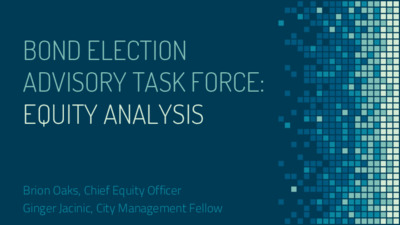Item 3.a. - Equity Office Presentation — original pdf
Backup

BOND ELECTION ADVISORY TASK FORCE: EQUITY ANALYSISBrion Oaks, Chief Equity OfficerGinger Jacinic, City Management Fellow 2How was the worksheet developed?○Originally designed to analyze budget items○Adaptation of the Equity Assessment Tool○6 Steps for Building Racial Equity- Government Alliance on Race and Equity (GARE)○Austin City Council’s 6 Strategic Priority Outcome AreasRecap: Equity Analysis Worksheet “3Recap: 6 Steps for Building Racial Equity1.Proposal: What is the policy, program, practice, or budget decision under consideration? What are the desired results and outcomes?2.Data: What are the data? What do the data tell us?3.Community Engagement: How have communities been engaged? Are there opportunities to expand engagement?4.Analysis and Strategies: Who will benefit from or be burdened by the proposal? What are the strategies for advancing racial equity or mitigating unintended consequences?5.Implementation: What is your plan for implementation?6.Accountability and Communication: How will you ensure accountability, communicate, and evaluate results?Government Alliance on Race and Equity (GARE) Austin City Council 6 Strategic Priority Outcome Areas:○Economic Opportunity and Affordability○Mobility○Safety○Health○Cultural and Learning Opportunities○Government that Works4Recap: Strategic Priority Outcome Areas “5Recap: Worksheet Analysis AreasWhat does the worksheet cover?1.Alignment: Do the proposal’s goals, metrics, and outcomes align?2.History: Does the proposal address and/or interrupt historical racial inequities?3.Data: Are the data disaggregated by race/ethnicity? 4.Community Engagement: Have communities of color been engaged effectively?5.Advancing Equity: Does the proposal advance equity in a specific outcome area?6.Unintended Outcomes: Are there potential unintended outcomes and impacts associated with the proposal?7.Breadth of Impact: Does the proposal impact a few people deeply or many people broadly? How did we complete the worksheet?1.Online form adaptation created without logic models due to time constraints 2.Online form distributed to departments to fill out3.Answers checked for completion and accuracy4.Equity Office staff reviewed submissions using the Equity Analysis Worksheet6Methodology “7Spreadsheet OverviewWhat do the spreadsheet colors mean?1.Green: Proposal has potential to advance racial equity2.Yellow: Proposal does not necessarily demonstrate potential to impact racial equity, but clearly addresses critical infrastructure needs3.Red: Proposal does not demonstrate potential to impact racial equity; unclear if a critical infrastructure need will be addressed Challenges and Themes:1.Enthusiastic responses from departments2.Thought exercise - Presented opportunity for departments to see proposals as part of a larger picture-an equitable Austin3.Disaggregated data are not frequently collected; existing census and ACS data sets are out of date 4.Departments are at times reluctant to name specific projects- often due to uncertainty regarding the size of the bond package5.Department community engagement is not well tracked and measured; general confusion between “engagement” and “outreach”8Findings “9Findings“Green” projects- in alphabetical order▪Affordable Housing▪Colony District Park- Phase II▪Colony Municipal Pool- Development ▪Dove Springs Neighborhood Center▪Holly Shores/Festival Beach- Phase II Implementation▪Neighborhood Partnering Program▪Police Park Patrol/ PARD Park Rangers J.U.F.▪Aquatic Program▪Sidewalk Rehabilitation & Replacement Program “Green” projects continued▪Stormwater- Flood Risk Reduction & Drainage Improvements▪Traffic Signals/ Advanced Transportation Management System▪Vision Zero/Safety▪Walter E. Long Metro Park- Phase I Implementation▪Watershed Open Space Land Acquisition10Findings “11FindingsHighlights:1.Affordable Housing: Neighborhood Housing and Community Development2.Vision Zero/Safety: Austin Transportation3.Dove Springs Neighborhood Center: Austin Public Health 12Findings Continued “13Findings Continued●44% of responses had all 10 boxes checked ○19 of 43 total submissions●30% of responses had only 1 box checked ○13 of 43 total of submissions●43% of all boxes checked were in Districts 1-4 (Eastern Crescent)○104 of 243 total boxes checked○Districts 1-4 are 75%-80% residents of color 1.This type of analysis is best when training is provided beforehand and common language is established2.Analysis was limited to information provided in submissions- Equity Office staff did not “infer” or apply outside knowledge3.Potential for response bias due to self-reported data4.Proposals were evaluated as they were submitted in October, and may have evolved based on working group November recommendations14Insights & Limitations “15Recommendations1.How do we determine which proposals make it to the Task Force?▫Community should help decide the initial “what” as well as the “how much”2.How do we maximize the impact on equity? What indicators exist to help us determine the return on investment? Questions?16